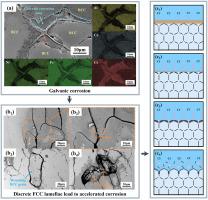激光熔覆Al-Co-Cr-Fe-Ni高熵合金相离散化诱导的非线性腐蚀响应机制
IF 4.8
2区 材料科学
Q2 CHEMISTRY, PHYSICAL
引用次数: 0
摘要
本研究采用电缆式焊丝激光熔覆(CTWW-LC)技术制备不同稀释率的Al-Co-Cr-Fe-Ni高熵合金(HEA)涂层,系统研究双相(BCC/FCC)结构对腐蚀行为的影响机理。通过微观组织表征、电化学测试和钝化膜成分分析,揭示了相间距和相比例对钝化膜腐蚀性能的定量调控规律。结果表明,在两相非常接近的区域,两相电位的差异会引起BCC相明显的局部腐蚀。此外,FCC相的比例表现出阈值效应:当FCC相的比例低于16.58%左右时,孤立的FCC片层触发“阴极离散”效应,加速了BCC基体的溶解,使腐蚀电流密度增加到8.874 × 10−6 a /cm2。但随着FCC相比例的增加,由于双相结构的连续性增强,耐蚀性逐渐恢复。本研究揭示了双相HEAs中相界面效应和相比例非线性响应的定量机理,为极端环境下高熵合金涂层的成分设计和工艺优化提供了理论依据。本文章由计算机程序翻译,如有差异,请以英文原文为准。

Phase discretization induced nonlinear corrosion response mechanism of Al-Co-Cr-Fe-Ni high-entropy alloys prepared by laser cladding
This study employed cable-type welding wire laser cladding (CTWW-LC) technology to fabricate Al-Co-Cr-Fe-Ni high-entropy alloy (HEA) coatings with different dilution rates, systematically investigating the influence mechanism of the dual-phase (BCC/FCC) structure on corrosion behavior. Through microstructural characterization, electrochemical testing, and analysis of the passive film composition, the quantitative regulatory laws of phase spacing and phase proportion on corrosion properties were revealed. The results indicate that in the areas where the two phases are very close to each other, the difference in the potentials of the two phases can cause significant local corrosion of the BCC phase. Moreover, the proportion of the FCC phase exhibits a threshold effect: when it is below about 16.58 %, isolated FCC lamellae trigger a “cathodic discretization” effect, accelerating the dissolution of the BCC matrix and increasing the corrosion current density to 8.874 × 10−6 A/cm2. However, as the proportion of the FCC phase increases, the corrosion resistance gradually recovers due to the enhanced continuity of the dual-phase structure. This study reveals the quantitative mechanisms of phase interface effect and nonlinear response of phase proportion in dual-phase HEAs, providing a theoretical basis for the compositional design and process optimization of high-entropy alloy coatings in extreme environments.
求助全文
通过发布文献求助,成功后即可免费获取论文全文。
去求助
来源期刊

Intermetallics
工程技术-材料科学:综合
CiteScore
7.80
自引率
9.10%
发文量
291
审稿时长
37 days
期刊介绍:
This journal is a platform for publishing innovative research and overviews for advancing our understanding of the structure, property, and functionality of complex metallic alloys, including intermetallics, metallic glasses, and high entropy alloys.
The journal reports the science and engineering of metallic materials in the following aspects:
Theories and experiments which address the relationship between property and structure in all length scales.
Physical modeling and numerical simulations which provide a comprehensive understanding of experimental observations.
Stimulated methodologies to characterize the structure and chemistry of materials that correlate the properties.
Technological applications resulting from the understanding of property-structure relationship in materials.
Novel and cutting-edge results warranting rapid communication.
The journal also publishes special issues on selected topics and overviews by invitation only.
 求助内容:
求助内容: 应助结果提醒方式:
应助结果提醒方式:


